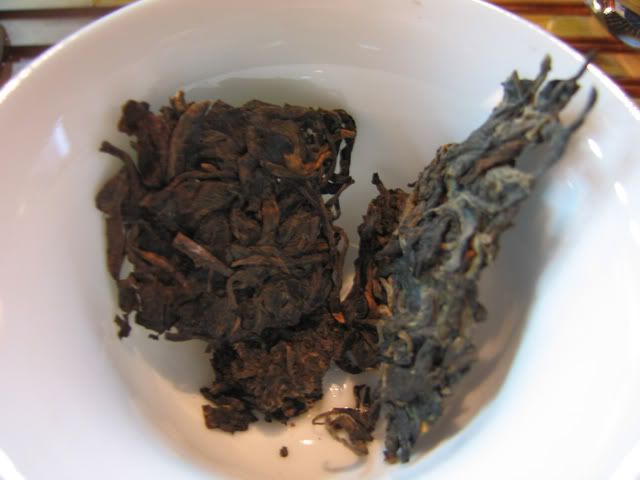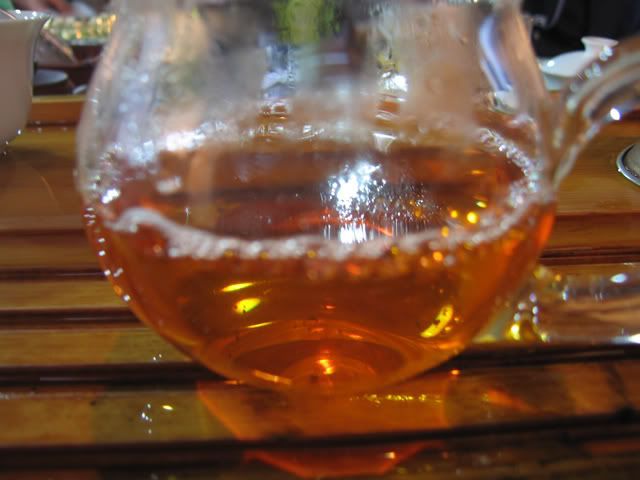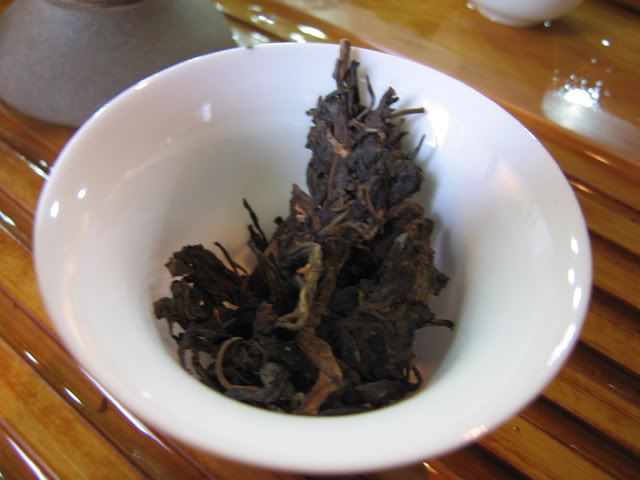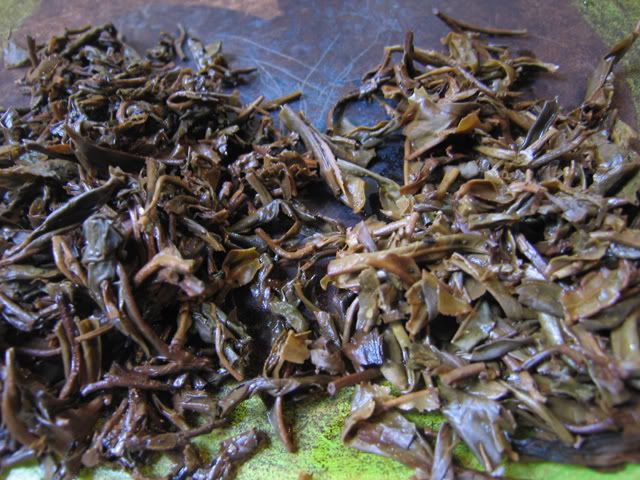I went to L’s place today for tea again. Quite a few people showed up throughout the afternoon, and we drank quite a few teas in the process.
They were already drinking when I got there. But the first two teas we had after I arrived were the two samples sent to me by Davelcorp. They were labeled sample A and B. We started with sample A, as I assumed that was the order I was supposed to go in. Sample A, when dry, smelled a little cooked for some reason. It doesn’t smell quite like a regular puerh would after a few years of aging. It’s a little dark, somewhat brown in colour.
The tea brewed up a reddish brown liquor. After a few infusions, it looked like this
The tea tastes a little funny for some reason. While the tea looks like a great puerh, and smells like an ok one, it has a funny taste… it’s got some slightly plumish taste, but not in the way that the 1997 Xizihao Yiwu taste. It’s also got a little sourness to it on the side of the mouth, and has a strange finish. I can’t quite pinpoint what’s wrong with it, but multiple people thought it a little odd without quite able to put their finger on it. In fact, I think I’ve tasted this before in my Keyixing bricks… they are somewhat, but not entirely, similar in taste. They are both a little thin in body. I wonder if this is a tea that didn’t have enough “kill-green” and turned a bit into a red tea.
The second tea we had was Sample B. Sample B smells a lot better than Sample A when dry. It’s got a nice aroma, smelling like maybe a Yiwu would after a few years of aging.
The tea has a lighter colour liquor than Sample A, but the taste was obviously fuller, with a nice aftertaste that hits the back of the mouth and the top of the throat. Everybody liked this tea. I am quite certain this is a Yiwu, perhaps Davelcorp’s beloved Menghai Yiwu cake that has been a subject of discussion on the LJ community recently. Whatever it is, it’s quite nice.
Here’s a comparative shot of A and B’s wet leaves
A on the left, B on the right. The colour might be a little too light, but B is definitely greener than A. B also has a more pungent “puerh-like” smell than A, which smells a bit vegetal. A is really quite similar to my Keyixing bricks, down to the smell of the wet leaves.
We then drank the Bulang that I bought recently. I like it, but L doesn’t, thinking it’s too bitter. I find it to have good energy, but maybe I’m just deluded?
Compared to the Zhongcha Banzhang cake we drank next, the Bulang is stronger, oddly enough, but the Banzhang has an obviously different flavour profile. I think for the cost differential, which is very substantial, the Bulang obviously wins. Without factoring in the cost, it will have to come to individual preferences.
We then sat around for a bit, and in the meantime, L got a call from Beijing about the newest prices from Zhongcha (with whom he has a dealership relationship). Prices have been reduced a little, which is definitely a good thing. I think there’s now some downward pressure on new cakes’ prices, and also on new maocha prices, because the level reached a month ago was simply too high — many stores could find no buyers, especially retail buyers, for their tea. At least L doesn’t gouge me, that I know. Not that I have bought much of anything from him, mind you. I think I’ve drank more tea from him than actual tea bought, which is a scary thought in and of itself.
Another guest arrived, and we switched to a dahongpao that Action Jackson got as a gift from Xiaomei, L’s business partner in Beijing (and which I hauled over). It’s actually quite nice, aromatic, and a very, very welcomed change from all the youngish puerhs we were drinking. We finished the day with a wet-stored cooked brick, which I didn’t find particularly interesting, but then, I rarely find any cooked stuff interesting, and certainly cannot justify high prices paid for such things.
One of the things that came up during discussion between me and Action Jackson today about younger puerhs is the matter of taste… and I realized that I no longer really drink any flavours of a youngish puerh, but rather the feeling of the tea. She said she liked the taste of one of the teas we had today over another, and asked me about flavours. It was then that I realized I was no longer looking at flavours… I didn’t even really pay much attention to it. Of course, I noted whether or not something was like what I think is the taste of a certain region, but… that almost no longer enter into the equation when I make that decision of whether or not this is a good tea, and whether or not this is something I would want to buy. It’s something worth thinking about… I should perhaps pay more attention to describing flavours, something which I’ve never been very good at.





 RSS - Posts
RSS - Posts
7 responses so far ↓
davelcorp // April 29, 2007 at 11:25 pm |
Interesting. Both of these are cakes that I enjoy quite a bit.
Sample A: is the famed 2001 Menghai Special Order Yi Wu that has the english-speaking tea internet all a buzz lately. I purchased this from Jing Tea about a year ago for $45ea. It is one of my favorite bings, and I hold hope for its aging potential. I think it’s ironic that you find it unlike the ’97 XZH, because I have been impressed by their similarities. Especially in aroma, texture, and aftertaste (given the difference in ages.) For $45 I thought it was a great purchase. I would not drop $165 for it.
Sample B: is a 2001 Fu Hai Yi Wu that I purchased from Stephane Erler a few years ago. I also paid $45ea for these (if I recall correctly.) It seems that he no longer offers these. It was one of the first bings that I bought for aging purposes. I enjoy this tea immensely, especially its aroma and after taste. However, after comparing it to the XZH, the Menhgai (sample A), looking at the leaves, etc, I’ve begun to suspect that it is a blend of Yi Wu mao cha and other maocha. At the least, I think it has some arbor maocha. However, I still am very happy with this tea.
Just curious, what were your brewing parameters for the tasting? I find the Menghai benefits from a larger than normal amount of leaf and short (flash) infusions.
MarshalN // April 30, 2007 at 12:00 am |
Wow, that’s a revelation.
Sample B tastes like aged Yiwus I know. Sample A does not.
I used 8g of leaves for both, with infusion parameters changing as necessary. 8g is a pretty generous amount of tea, I think.
There’s really a similarity between A and my Keyixing bricks. I should send you a sample of those and you can compare, but they’re in Beijing so you’ll have to wait for that. B, IMHO, is much better than A. $45 at a few years ago was a bit expensive, but in the current market it’s not.
How do you store the teas?
davelcorp // April 30, 2007 at 12:50 am |
The samples I sent you are from open bings that sit on a bookshelf in my living-room. They are open to the environment without much consideration for longterm storage as they are intended for drink-now purposes.
Stored teas are locked up (away from the prying hands of a 3yr-old) in a metal cabinet with ventilation slots. It is close to an open window that allows for fluctuation in humidity. It is packed top to bottom with puerh and smells strongly of tea. One of my favorite things to do is open it and just soak up the aroma.
Phyllo // April 30, 2007 at 1:05 am |
Funny. Last year (Sept?) Dave also sent me the 01 Menghai Yiwu blind. It was labelled as “Mystery Yiwu”. I slammed the tea at first because I used only a little amount of leaves and long brewing time. Dave sent me the sample right after I wrote the bit about M. Erler’s 2003 Yiwu beeng, so I was experimenting with that brewing method because it worked well with the M. Erler’s tea.
And then later I used a lot of leaves and short infusion time, and the tea came out quite nicely. I wouldn’t drop $165 for that tea, too.
MarshalN // April 30, 2007 at 1:32 am |
Interesting. My infusion times were not too long, since I used a pretty generous amount of leaves.
The tea was not bitter. Instead, it had a bit of a strange taste, and compared with the Fuhai, it was not as good, IMO.
I really need to taste this against that brick of mine to see if I can find big differences/similarities. When I was drinking it yesterday I couldn’t help but feel like they are very, very similar teas.
HobbesOxon // April 30, 2007 at 6:16 am |
I’ve got some of sample B already, and I think sample A (literally) just got delivered while I write this.
Haha – yes! It is indeed. I now have samples A and B, so I’ll try a not-so-blind equivalent.
Toodlepip,
Hobbes
MarshalN // April 30, 2007 at 7:46 am |
Oh, ooops, I didn’t know I revealed the secrets of A and B!
Or maybe Davelcorp is sneaky that way and mixed them up 🙂